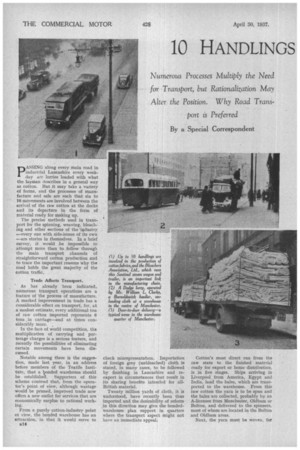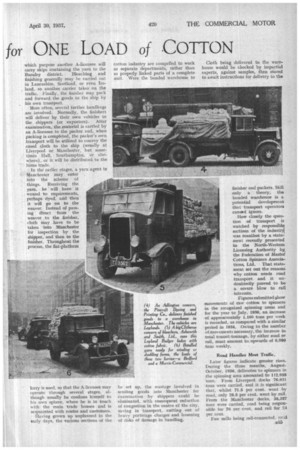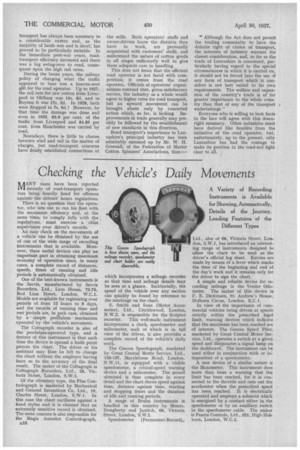10 HANDLINGS
Page 124

Page 125

Page 126

If you've noticed an error in this article please click here to report it so we can fix it.
for ONE LOAD of COTTON Numerous Processes Multiply the Need for Transport, but Rationalization May Alter the Position. Why Road Transport is Preferred By a Special Correspondent pASSING along every main road in industrial Lancashire every weekday are lorries loaded with what the layman describes in a general way as cotton. But it may take a variety of forms, and the processes of manufacture and sale are such that six to 10 movements are involved between the arrival of the raw cotton at the docks and its departure in the form of material ready for making up.
The precise methods used in transport for the spinning, weaving, bleach
ing and other sections of the -industry —every one with side-issues of its own
—are stories in themselves. In a brief survey, it would be impossible to attempt more than to follow through
the main transport channels of straightforward cotton production and to trace the important reasons why the road holds the great majority of the cotton traffic.
Trade Affects Transport.
As has already been indicated, numerous transport operations are a feature of the process of manufacture. A marked improvement in trade has a considerable effect on transport, for, at a modest estimate, every additional ton of raw cotton imported represents 6 tons in carriage—and at times considerably more.
In the face of world competition, the multiplication of carrying and porterage charges is a serious feature, and recently the possibilities of eliminating certain movements have been discussed.
Notable among these is the suggestion, made last year, in an address before members of the Textile Institute, that a bonded warehouse should be established. Supporters of this scheme contend that, from the operator's point of view, although wastage would be pruned, improved trade now offers a new outlet for services that are economically surplus to rational working.
From a purely cotton-industry point oi view, the bonded warehouse has an attraction, in that it would serve to a1.4 check misrepresentation. Importation of foreign grey (unbleached) cloth is stated, in many cases, to be followed by finishing in Lancashire and reexport in circumstances that result in its sharing benefits intended for allBritish material.
Twenty million yards of cloth, it is understood, have recently been thus imported and the desirability of reform in this direction may give the bondedwarehouse plan support in quarters where the transport aspect might not have an immediate appeal. Cotton's most direct run from the raw state to the finished material ready for export or home distribution, is in five stages. Ships arriving in Liverpool from America, Egypt and India, land the bales, which are transported to the warehouse. From this raw cotton the yarn is to be spun and the bales are collected, probably by an A-licensee from Manchester, Oldham or Bolton, and delivered to the spinners, most of whom are located in the Bolton and Oldham areas.
Next, the yarn must be woven, for which purpose another A-licensee will carry skips containing the yarn to the Burnley district. Bleaching and finishing generally may be carried out in Lancashire. Scotland, or even Ireland, so another carrier takes on the traffic. Finally, the finisher may pack and forward the goods to the ship by his own transport.
More often, several further handlings are involved. Normally, the finishers will deliver by their own vehicles to the shippers (or exporters). After examination, the material is carried by an A-licensee to the packer and, when packing is completed, the packer's own transport will be utilized to convey the cased cloth to the ship (usually at Liverpool or Manchester, but sometimes Hull. Southampton, or elsewhere), or it will be distributed to the home trade.
In the earlier stages, a yarn agent in Manchester may enter into the scheme of things. Receiving the yarn, he • will have • it wound to requirements, perhaps dyed, and then it will go on to the weaver. Instead of passing direct from • the weaver to the finisher, cloth may have to be taken into Manchester for inspection by the .shipper, and then to the ,finisbex. Throughout the process, the fiat-platform lorry is used, so that the A-licensee may operate through several stages, although usually he confines himself to his own sphere, where he is in touch with the main trade houses and is acquainted with routes and customers.
Having grown up unplanned in the early days, the various sections of the cotton industry are compelled to work as separate departments, rather than as properly linked parts of a complete unit. Were the bonded warehouse to be set up, the wastage involved in sending goods into Manchester for examination by shippers could be elithinated, with consequent reduction of congestion in the centre of the city, saving in transport, cutting out of heavy porterage charges and lessening of risks of damage in handling.
Cloth being delivered to the warehouse would be checked by impartial experts, against samples, then stored to await instructions for delivery to the
finisher and packers. Still only a theory, the bonded warehouse is a potential development that transport operators cannot ignore.
How closely the question of transport is watched by responsible sections of the industry! was manifest by a statement recently presented to the North-Western Licensing Authority by the Federation of Mastef Cotton Spinners Associations, Ltd. That statement set out the reasons why cotton needs road transport and it undoubtedly proved to ho a severe blow to rail interests.
Figures submitted show movements of raw cotton to spinners in the recognized spinning areas and for the year to July, 1936, an increase of approximately 1,100 tons per week is recorded, as compared with a similar period in 1934. Owing to the number of movements necessary, the increase in total transit-tonnage, by either road or rail, must amount to upwards of 6,000 tons weekly.
Road Handles Most Traffic.
Later figures indicate greater rises. During the three months, August. October, 1936, deliveries to spinners in the spinning area amounted to 112,958 tons. From Liverpool docks 76,631 tons were carried, and it is significant that, whilst 71.5 per cent. went by road, only 28.5 per cent, went by rail. From the Manchester docks, 36.327 tons were carried, road being responsible for 76 per cent. and rail for E4 per cent. Few mills being rail-connected, ro-4 transport has always been necessary to a considerable extent and, as the majority of hauls was and is short, has proved to be particularly suitable. In the immediate post-war years, roadtransport efficiency increased and there was a big swing-over to road, consequent upon the high rail rates.
During the boom years, the railway policy of charging what the traffic appeared to bear was a heaven-sent gift for the road operator. Up to 1927, the rail rate for raw cotton from Liverpool to Oldham was 15s. 8d. and to Royton it was 17s. 2d. In 1928, both were dropped to 7s. 6d.! However, by that time the damage was done and even in 1935, 63.9 per cent, of the traffic from Liverpool and 84.89 per cent. from Manchester was carried by road.
Nowadays, there is little to choose between road and rail in the matter of charges, but road-transport concerns have firmly established connections at the mills. Both operators' staffs and owner-drivers know the districts they have to work, are personally acquainted with customers' staffs, and understand the nature of cotton goods in all stages sufficiently well to give them adequate care in handling.
This does not mean that the efficient road operator is not faced with competition; it comes from the road operator. Officials of operators' organizations contend that, given satisfactory service, the industry as a whole would agree to higher rates for road transport, but an upward movement can be brought about only by concerted action which, so far, is lacking. Improvements in trade generally may possibly be followed by the establishment of new standards in this direction.
Road transport's importance to Lancashire's principal industry has been admirably summed up by Mr. W. H. Greene11, of the Federation of Master Cotton Spinners' Associations, thus:— " Although the Act does not permit the trading community to have the definite right of choice of transport, the interests of industry warrant the closest consideration, and, so far as the trade of Lancashire is concerned, particularly having regard to the special circumstances in which it is carried on, it should not be forced into the use of any form of transport which it considers is not best suited to its own requirements. The welfare and expansion of the country's trade is of far greater importance to the whole country than that of any of the transport undertakings."
Everyone who is willing to look facts in the face will agree with this downright summary. Other industries must have derived like benefits from the initiative of the road operator, but, unfortunately, up to the present, only Lancashire has had the courage to make its position in the road-rail fight clear to all.








































































































































































